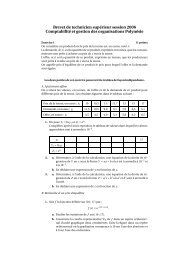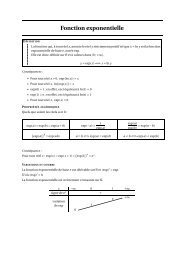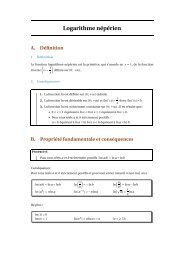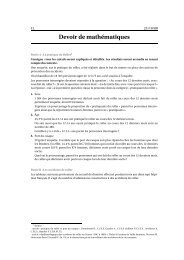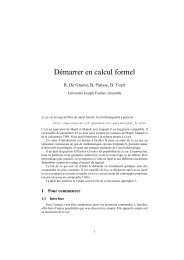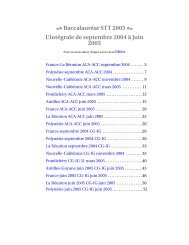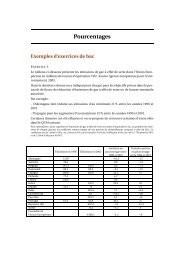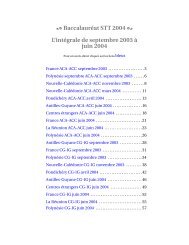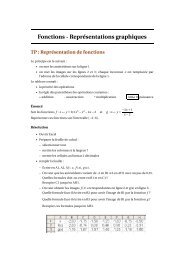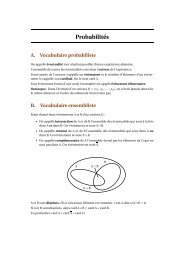Algorithmes de calcul formel - Free
Algorithmes de calcul formel - Free
Algorithmes de calcul formel - Free
- No tags were found...
Create successful ePaper yourself
Turn your PDF publications into a flip-book with our unique Google optimized e-Paper software.
(les inconnues étant par ordre décroissant les coefficients <strong>de</strong> U et V )⎛⎞a a a a−1 . . . . . . a 0 0 . . . 00 a a . . . . . . a 1 a 0 . . . 0..M(A, B) =0 0 . . . a 0b b b b−1 . . . b 0 0 0 . . . 0⎜⎟⎝ .. ⎠0 0 . . . b 0(cette matrice contient b =<strong>de</strong>gré(B) lignes <strong>de</strong> coefficients du polynôme A et a =<strong>de</strong>gré(A)lignes <strong>de</strong> coefficients du polynôme B)Lien avec l’algorithme du sous-résultant (<strong>calcul</strong> <strong>de</strong> PGCD)On peut <strong>calcul</strong>er le déterminant avec la suite <strong>de</strong>s restes <strong>de</strong> divisions euclidiennes<strong>de</strong> la manière suivante, on part <strong>de</strong> la pseudo-division <strong>de</strong> A par B :b a−b+1bA = BQ + Ron effectue alors sur chaque ligne contenant les coefficients <strong>de</strong> A la manipulation<strong>de</strong> ligne correspondante, c’est-à-dire multiplier la ligne par b a−b+1bet soustraire (q 0fois la ligne <strong>de</strong> B terminant dans la même colonne+q 1 fois la ligne <strong>de</strong> B terminantune colonne avant+...). Toutes les lignes contenant les coefficients <strong>de</strong> A ont étéremplacées par <strong>de</strong>s lignes contenant les coefficients <strong>de</strong> R. Ces lignes contiennentk zéros initiaux avec k ≥ 1, ce qui permet <strong>de</strong> réduire le déterminant à celui <strong>de</strong> lamatrice <strong>de</strong> Sylvester <strong>de</strong> R et B (à un coefficient multiplicatif près qui vaut b k b parrapport au précé<strong>de</strong>nt donc b k−b(a−b+1)bpar rapport au déterminant <strong>de</strong> départ). Onéchange ensuite R et B ce qui change éventuellement le signe et on continue enfaisant les divisions euclidiennes <strong>de</strong> l’algorithme du sous-résultant (cf. Knuth où onutilise la matrice <strong>de</strong> Sylvester pour prouver que l’algorithme du sous-résultant estcorrect). Rappelons que le sous-résultant définit les suites A k (A 0 = A, A 1 = B),d k le <strong>de</strong>gré <strong>de</strong> A k , δ k = d k − d k+1 , g k (g 0 = 1, si k ≠ 0, g k coefficient dominant<strong>de</strong> A k ) h k (h 0 = 1, h k+1 = h 1−δ kkg δ kk+1 ) etg δ k−1+1kA k−1 = A k Q k+1 + g k−1 h δ k−1k−1 A k+1Théorème 3 Le résultant est égal au signe près au coefficient h k où k correspondau reste A k constant (en supposant que le résultant soit non nul).PreuveLa transcription <strong>de</strong> l’égalité précé<strong>de</strong>nte sur les résultants donne par la métho<strong>de</strong>ci-<strong>de</strong>ssus :g (δ k−1+1)d kkRes(A k−1 , A k ) = g d k−1−d k+1kRes(g k−1 h δ k−1k−1 A k+1, A k )On en déduit que :Res(A k−1 , A k )g d kk−1 hd k−1−1k−1= g d k−1−d k+1k(g k−1 h δ k−1k−1 )d kRes(A k+1 , A k )= g d k−1−d k+1 −(δ k−1 +1)d kkh δ k−1d k +1−d k−1k−1Res(A k+1 , A k )37



